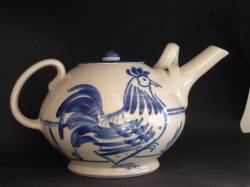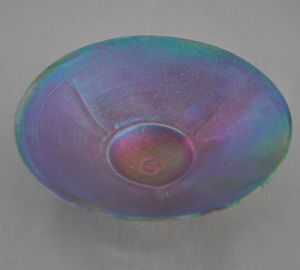Technical
Blue and White
My domestic pottery has been at the heart of my studio practice for over thirty years. There is the meditation of repetitive throwing yet always aiming for a higher standard, pushing yourself to make each piece perfect. Then I love the fine brush work always aiming to distill the essence of the creature that I am painting, along with beauty in the line itself. The design on each piece varies with the form it has to sit on and my mood on the day.
My pots are all hand thrown using porcelanious stoneware clay. They are then half dried, turned and the designs are painted on freehand after I rough in the design using a soft pencil.
The pots are then fired to make them ceramic, so that they can no longer be dissolved in water, I fire this first or bisque firing to 850 degrees celcius. The kiln is cooled and unpacked and then they need to be glazed. The pots are dipped in the glaze which I make up of a set recipe of minerals which are weighed and mixed then seived.
Once again they are fired to 1280 degrees celcuis which is just off white heat. This has to cool overnight and the work is then unpacked from the kiln and sorted. Then the bases are ground, stickers and swing tags applied and the piece is finally finished.
Reduced Arabic Lustre by Emily Laszuk
This is an ancient technique which appears to have arisen from the Alchemists and their explorations.
Clay is shaped as usual then fired and then layers of glaze are applied. This glaze contains ingredients such as real silver, copper and bismuth nitrate. I use a combination of glazes which fire at different temperatures so need multiple firings. Finally the last firing is the reduction one where wonderful colours can emerge. The glazes are usually soft alkaline glazes with tin oxide which helps to create the best reactions.
The atmosphere of the kiln is the amount of oxygen it contains. If you close off the air into the kiln the flame has to find oxygen to burn so finds it in the chemical composition of the clay and the glazes, this is a reduction firing. This sounds very academic but in real life leads to a smoky, smelly, flame filled kiln room, all very exciting. The results are difficult to predict and this keeps the magic alive.
This can take many firings, many late nights peering into the fiery furnace. There is a lot of experimenting and recording as I seek to chase the dragon. It’s a search for the elusive beauty and the momentary capturing of the path of the flame on the clay. In each firing there are usually less than 50% of pots which make the grade.
Each pot comes alive in your hand when exposed to different light; there is always more than you see at first glance. It’s a seductive and frustrating medium with moments of pure joy that keep you going on the journey.
